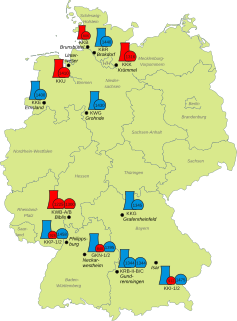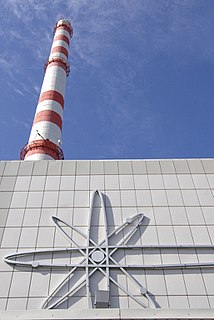
A nuclear power phase-out is the discontinuation of usage of nuclear power for energy production. Often initiated because of concerns about nuclear power, phase-outs usually include shutting down nuclear power plants and looking towards fossil fuels and renewable energy.

Nuclear energy policy is a national and international policy concerning some or all aspects of nuclear energy and the nuclear fuel cycle, such as uranium mining, ore concentration, conversion, enrichment for nuclear fuel, generating electricity by nuclear power, storing and reprocessing spent nuclear fuel, and disposal of radioactive waste.

The Kola Nuclear Power Plant, also known as Kolsk NPP or Kolskaya NPP, is a nuclear power plant located 12 km away from Polyarnye Zori, Murmansk Oblast in north-western Russia.

Russia is one of the world's largest producers of nuclear energy. In 2018 total electricity generated in nuclear power plants in Russia was 202.87 TWh, 20.8% of all power generation. The installed gross capacity of Russian nuclear reactors is 31,315 MW by December 2018.

The Armenian Nuclear Power Plant (ANPP), also known as the Metsamor Nuclear Power Plant, is the only nuclear power plant in the South Caucasus, located 36 kilometers west of Yerevan in Armenia. The ANPP complex consists of two VVER-440 Model V270 nuclear reactors, each capable of generating 407.5 megawatts (MW) of power, for a total of 815 MW. The plant supplied approximately 40 percent of Armenia's electricity in 2015.
Kazakhstan owns large reserves of energy resources, and therefore the energy policy of Kazakhstan has influence over the world's overall energy supply. Although Kazakhstan has not described itself as an energy superpower, Kazakhstan's president Nursultan Nazarbayev has claimed Kazakhstan will become a factor of energy security in Asia and Europe. Kazakhstan has a strategic geographical location to control oil and gas flows from Central Asia to East (China) and West.

Floating nuclear power stations are vessels designed by Rosatom. They are self-contained, low-capacity, floating nuclear power plants. The stations are to be mass-produced at shipbuilding facilities and then towed to the destination ports of the cities and towns experiencing deficit of power due to industrialization.

Nuclear power in Italy is a controversial topic. Italy started to produce nuclear energy in the early 1960s, but all plants were closed by 1990 following the Italian nuclear power referendum. As of 2018, Italy is one of only two countries, along with Lithuania, that completely phased out nuclear power for electricity generation after having operational reactors.

Atomstroyexport is the Russian Federation's nuclear power equipment and service exporter. It is a fully owned subsidiary of Rosatom. The activities of Atomstroyexport are financially supported by the Russian government. The President of ASE Group of Companies is Alexander Lokshin.

The Belarusian nuclear power plant is a multi-reactor nuclear power plant project in Belarus. Initial plans were announced in the 1980s, but were suspended after the 1986 Chernobyl disaster. The drive for the current project was fueled by the Russia-Belarus energy dispute in 2007. The project foresees construction of two nuclear reactors between 2016 and 2020, and probably two more reactors by 2025. The reactors would be supplied by Atomstroyexport and the plant would be located in the Astravyets District, Grodno Region.

Energy in Armenia describes energy and electricity production, import and consumption in Armenia.

ARMZ Uranium Holding Co. is a Russian uranium mining company. It is wholly owned by Atomenergoprom, a part of Rosatom.
National nuclear energy policy is a national policy concerning some or all aspects of nuclear energy, such as mining for nuclear fuel, extraction and processing of nuclear fuel from the ore, generating electricity by nuclear power, enriching and storing spent nuclear fuel and nuclear fuel reprocessing. Nuclear energy policies often include the regulation of energy use and standards relating to the nuclear fuel cycle.
There is only one nuclear reactor in Ghana, the Ghana Research Reactor, located in Accra.

Turkey has no nuclear power plants but the first is expected to come online in 2023. In addition to these, the government has announced intentions for three further nuclear power plants with four reactors each, as part of 100 GWe required by 2030.
In December 2016, the Jordan Atomic Energy Commission (JAEC), in cooperation with a consortium headed by the Korean Atomic Energy Research Institute, inaugurated the 5 MW Jordan Research and Training Reactor. The facility is the first nuclear reactor in the county. It will provide radioactive isotopes for medical usage in Jordan, and will provide training for students at the University to produce a skilled workforce for the country's planned commercial nuclear reactors.
NUKEM Technologies GmbH is a nuclear engineering and consulting company managing radioactive waste and spent fuel and decommissioning of nuclear facilities. The company is located in Alzenau, Germany. It was established in 2006 as a subsidiary of Nukem Energy. On 14 December 2009, Nukem Technologies was sold to Russian Atomstroyexport for €23.5 million.
The Ninh Thuận 1 Nuclear Power Plant is a planned nuclear power plant at Phước Dinh in Thuận Nam District, Ninh Thuận Province, Vietnam. It will consist of four 1,200 MWe VVER pressurised water reactors. The plant to be built by Atomstroyexport, a subsidiary of Rosatom. It will be owned and operated by state-owned electricity company Vietnam Electricity. Fuel will be supplied and used fuel will be reprocessed by Rosatom. The feasibility study will be carried out by E4 Group.

The electricity sector of Armenia includes several companies engaged in electricity generation and distribution. Generation is carried out by multiple companies both state-owned and private.
The energy crisis in Armenia, popularly known as the dark and cold years, refers to the energy crisis in Armenia during the 1990s, when the newly-independent Armenia's population lived in shortage of energy and basic consumer goods. Although it only lasted 3-4 years, it left a deep impact and impression. Local people have dubbed the years from 1992 to 1995 in different ways, such as "hungry", "cold", and "bad", but the most common title used is "the dark."













